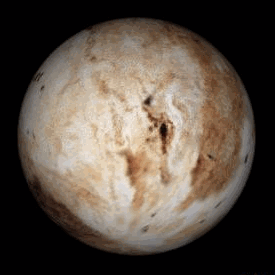PLUTO 

Pluto
Pluto, (PLOO toh), is a dwarf planet that orbits far from the sun. It shares the region of its orbit, known as the Kuiper belt, with a collection of similar icy bodies called Kuiper belt objects (KBO’s). From its discovery in 1930, people widely considered Pluto to be the ninth planet of our solar system. However, because of its small size and irregular orbit, many astronomers questioned whether Pluto should be grouped with worlds like Earth and Jupiter. Pluto seemed to share more similarities with KBO’s. In 2006, this debate led the International Astronomical Union, the recognized authority in naming heavenly objects, to formally classify Pluto as a dwarf planet. Pluto cannot be seen without a telescope.
Pluto is about 39 times as far from the sun as Earth is. Its average distance from the sun is about 3,647,240,000 miles (5,869,660,000 kilometers). Pluto travels around the sun in an elliptical (oval-shaped) orbit. At some point in its orbit, it comes closer to the sun than Neptune, the outermost planet. It stays inside Neptune's orbit for about 20 Earth years. This event occurs every 248 Earth years, which is about the same number of Earth years it takes Pluto to travel once around the sun. Pluto entered Neptune's orbit on Jan. 23, 1979, and remained there until Feb. 11, 1999. As it orbits the sun, Pluto spins on its axis, an imaginary line through its center. It spins around once in about six Earth days.
Astronomers know little about Pluto's size or surface conditions because it is so far from Earth. Pluto has an estimated diameter of about 1,400 miles (2,300 kilometers), less than a fifth that of Earth. Pluto's surface is one of the coldest places in our solar system. Astronomers believe the temperature on Pluto may be about –375 °F (–225 °C).
Pluto is mostly brown. The planet appears to be partly covered with frozen methane gas and to have a thin atmosphere composed mostly of methane. Because Pluto's density is low, astronomers think Pluto is mainly icy. Scientists doubt Pluto has any form of life.
In 1905, Percival Lowell, an American astronomer, found that the force of gravity of some unknown object seemed to be affecting the orbits of Neptune and Uranus. In 1915, he predicted the location of a new planet and began searching for it from his observatory in Flagstaff, Arizona. He used a telescope to photograph the area of the sky where he thought the planet would be found. He died in 1916 without finding it. In 1929, Clyde W. Tombaugh, an assistant at the Lowell Observatory, used predictions made by Lowell and other astronomers and photographed the sky with a more powerful, wide-angle telescope. In 1930, Tombaugh found Pluto's image on three photographs. The planet was named after the Roman god of the dead. The name also honors Percival Lowell, whose initials are the first two letters of Pluto.
In 1978, astronomers at the U.S. Naval Observatory substation in Flagstaff detected a satellite of Pluto. They named it Charon. This satellite has a diameter of about 750 miles (1,210 kilometers).
In 1996, astronomers published the first detailed images of Pluto's surface. The images, taken by the Hubble Space Telescope, show about 12 large bright or dark areas. The bright regions, which include polar caps, are probably frozen nitrogen. The dark areas may be methane frost that has been broken down chemically by ultraviolet radiation from the sun.












